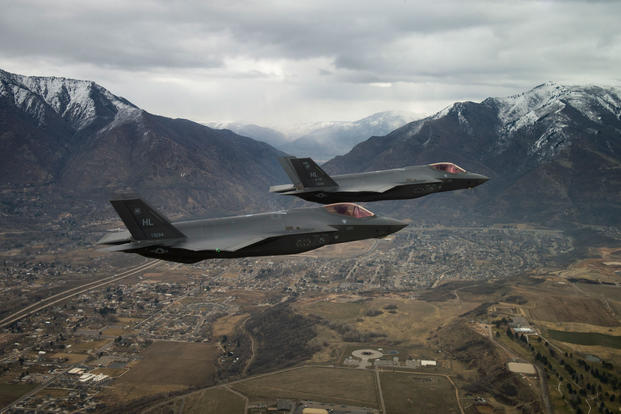The Defense Department is again accepting F-35 Joint Strike Fighters after suspending deliveries from its manufacturer, Lockheed Martin Corp., over a disagreement over who would pay to correct corrosion issues due to a production error.
The F-35 Joint Program Office resumed acceptance of new stealth fighters May 1; deliveries had been on hold since March 29, according to spokesman Joe DellaVedova.
JPO, along with "the U.S. services, international allies and Lockheed Martin, have implemented a comprehensive corrective action plan to make the necessary repairs to all aircraft while minimizing impact to operations," he said in a statement to Military.com on Tuesday.
"The majority of aircraft will be complete within 24 months, with the remaining aircraft completed as their availabilities/modification timing allows," DellaVedova added.
"This remediation plan will ensure the warfighter continues to receive an affordable and quality weapons system from industry," he said.
The decision to resume delivery was first reported by Reuters on Monday.
Related content:
- Pentagon Suspends F-35 Deliveries Over New Corrosion Issues: General
- As Services Take Greater Role on F-35, Joint Program Office to Remain
- With Older F-35s 'On Life Support,' Wing Struggles to Train Pilots
The problem could have affected as many as 200 aircraft, according to a report from Defense News. The problem originally surfaced in September, with officials stopping delivery the first time in the fall, Defense News said.
Military officials on April 12 confirmed that deliveries had again been temporarily suspended because of corrosion issues in fastener holes "that were drilled and not corrected or properly treated found during an inspection at Hill Air Force Base, [Utah]," said Lt. Gen. Arnold Bunch, the Air Force's military deputy for the Office of the Assistant Secretary for Acquisition at the Pentagon.
"We do not see it as a long-term problem, and if we have an operational need for the aircraft, we have discussed [it] with [Vice] Adm. [Mat] Winter," Bunch told lawmakers during a House Armed Services subcommittee at the time. Winter is the director of the F-35 Joint Program Office.
Michael Friedman, a Lockheed spokesman, said an agreement was reached on correcting the problem but did not disclose who will end up paying the bill.
"The Pentagon has resumed accepting F-35 aircraft, following an agreement between the F-35 Joint Program Office and Lockheed Martin to effectively and efficiently address the F-35 hole primer issue," Friedman said.
"While we don't discuss specific cost figures and contracting terms, we have a comprehensive plan in place to effectively and efficiently address the F-35 hole primer issue," he said in an email. "All F-35 production continued during the delivery pause, and Lockheed Martin remains on track to meet its delivery target of 91 aircraft for 2018.
"Fourteen of the Lot 10 F-35 aircraft had been delivered to the military, Bunch said, but five remained with Lockheed: three F-35As for the Air Force, one for Norway and one for Australia.
-- Oriana Pawlyk can be reached at oriana.pawlyk@military.com. Follow her on Twitter at @Oriana0214.










